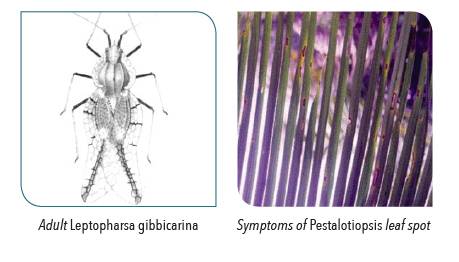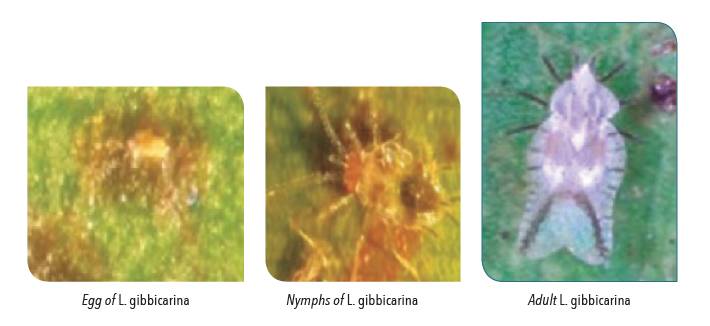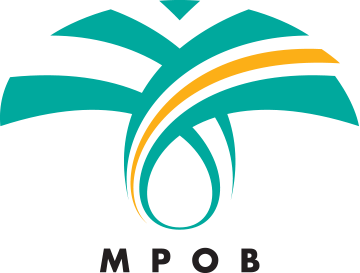General Information

Leptopharsa gibbicarina feeds along the entire length of the leaflet of oil palm. The punctures by the stylets cause depigmentation of the leaflets. In severe infestations, the leaflets can turn completely white. However, it is not the direct damage that is the most serious. The feeding wounds from the lace bug provide access to invasion by the fungal pathogen, Pestalotiopsis palmarum, which causes grey leaf blight (or also known as Pestalotiopsis leaf spot).
First symptom of Pestalotiopsis leaf spot is the development of small brown spots with yellowish haloes. As the disease progresses, the spots coalesce into brown necrotic areas that spread throughout the leaves. The leaves eventually turn grey and brittle. The condition can occur at any stage of the palm, but is generally more severe in plantations over five years and can cause higher production reductions (up to 36% due to decline in photosynthetic capacity of the leaflets). Bunch reduction of as much as 18 – 20 t ha-1, and crop loss of up to 40% due to this disease have been recorded.
Distribution
Colombia
Detection and Inspection
ADULT
About 2.5 mm long and 1.2 mm wide. Translucent white with lateral expansions foliaceae, transparent and dorsal carinae well developed on the prothorax. The total life cycle varies between 40 and 73 days, with an incubation period of the egg stage about 15 days with five nymphal instars. The adult has a longevity between 20 and 36 days.
NYMPHS
Newly emerged nymphs are translucent creamy white head and orange eyes, and then change to a dark dusky and abdomen becomes black.
EGGS
Elliptical, 0.6 mm long, hyaline cream and become opaque cream with orange spots when they are close to hatching; are located within the substance alone or of the leaflet surface, both near the rib.
Prevention and Control
PHYTOSANITARY
Eggs and young larvae are difficult to detect via visual inspection. Only the larger mature adults are more likely to be detected. Source germplasm from pest free areas, and ensure sanitation from sourcing to shipping. The import of germplasm material (seeds, pollen, tissue culture) must be accompanied by an import permit issued by or on behalf of the Director-General of Agriculture for Peninsular Malaysia (including Labuan), or the Director of Agriculture for Sabah, and a phytosanitary certificate issued by an authorised official from the country of export. The import conditions are available upon request from the Plant Biosecurity Division Malaysia. All consignments are subjected to inspection by the Department of Agriculture prior to clearance by Customs. Germplasm material imported from high risk areas should be sent for third country quarantine before arrival onto Malaysian shores. The import of alternative host plant parts i.e. Aiphanes sp. and Bactris sp. from infested areas should be enquired with DOA.

CULTURAL CONTROL AND SANITARY METHODS
Reduction of leaf spot is most effective through insecticidal control of lace bug. Treatment with acephete through trunk injection also can be applied.
Further reading
- Escalante, M; Dams, D; Marquez, D; Gelvez, W; Chacon, H; Asdrubal and Moreno, B D (2010). Diagnosis and evaluation of Pestalotiopsis, and insect vectors, in an oil palm plantation at the South of Lake Maracaibo, Venezuela. Bioagro, 22(3): 211-216.
- Froehschner, R C (1976). Description of a new species of lace bug attacking the oil palm in Colombia (Hemiptera: Tingidae). Proc. of the Entomological Society of Washington, 78: 104-107.
- Labarca, M; Sanabria, N and Arcia, A (2006). Pestalotiopsis palmarum Cooke pathogenicity on nursery-oil palm (Elaeis guineensis Jacq.) plants. Rev. Fac. Agron. (LUZ) 23: 414-421.
- Mariau, D (2001). The fauna of oil palm and coconut: Insect and mites pests and their natural enemies. La Librairie du CIRAD: France. 264 pp.
- Schaefer, C W and Panizzi, A R (eds.) (2000). Heteroptera of economic importance. CRC Press: USA. 846 pp.
- Trilleras, C E B T and Pardey, A E B (2014). Biología de la chinche de encaje Leptopharsa gibbicarina y su control con hongos entomopatógenos. Ceniavances No. 180.

